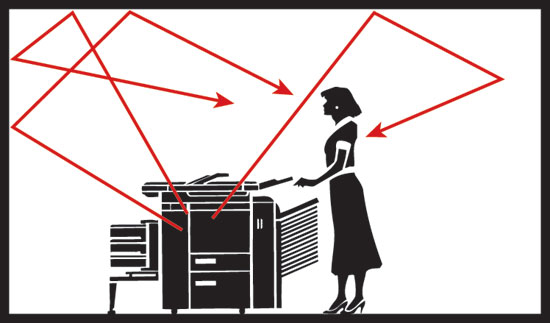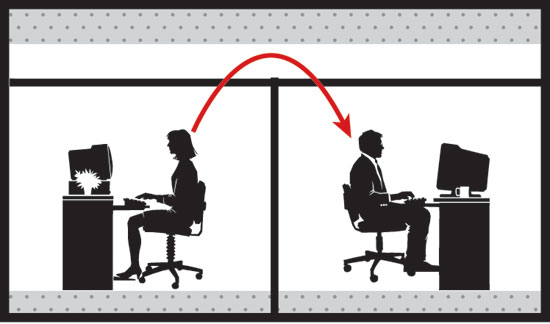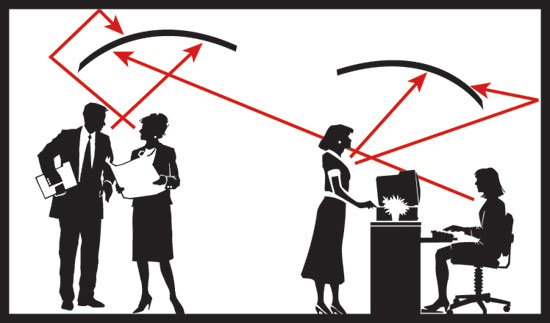A New World of Acoustics
Sound is typically characterized by its loudness and frequency content, such that loudness is measured in decibels (dB) and frequency is measured in Hertz (Hz). The sound as heard within a space will be a combination of direct sound from the sources and sound reflected off the various surfaces within the space. Highly reflective surfaces will redirect sound without significant changes except for direction, which in very “hard” rooms can result in long delay times for arrival at the listener, causing echoes. Highly sound-absorptive surfaces on the other hand will diminish the reflected sound waves and reduce reverberation and echoes. Based on the sound behavior, people can experience different levels of speech intelligibility, speech privacy, or sound intrusion depending on the room size and shape and the acoustic treatments within or between spaces.



Images courtesy of Armstrong Ceiling and Wall Systems
Sound radiates out in all directions, but materials within a space will influence its effect on people. Materials with a high NRC (top image) dampen sound, those with a high CAC (middle image) reduce sound transfer through ceilings, and Sabin measurements (bottom image) determine effects of freestanding baffles.
Finding the right combination of sound absorption/reflection and sound attenuation (blocking) for a given space is a matter of using several well-developed tools to balance the acoustic characteristics within that space. (See sidebar in the online version of this course.) Sound absorption is the ability of a material or surface to deaden sound and is always frequency dependent. The sound absorption coefficient is measured on a scale of 0.0 – 1.0 over a frequency range, and the single number rating for a material is called the Noise Reduction Coefficient (NRC). The higher the NRC rating, the higher the overall (averaged over frequency) sound absorption of the material being measured. The NRC values published in ceiling manufacturers' data represent the percent of sound absorption per square foot of material used in continuous ceilings. If discontinuous ceilings are being installed or only partial areas have acoustic treatment (considered “unit” absorbers), then the overall sound absorption of the entire space can be measured and published as Sabins of absorption. Since we need to know the total sound absorption (Sabin) within a space, we can multiply the NRC by the number of square feet of continuous ceiling or we can add up the unit Sabins for the number and type of partial acoustical treatments that are in place.

Photo courtesy of Armstrong Ceiling and Wall Systems
Clouds and canopies are three-dimensional ceilings that are available in a variety of materials and acoustical properties.
The opposite of sound absorption is sound reflection which is also measured in the same way. A material with an NRC of 0.0 will reflect back all of the sound striking it and not absorb any. Typically, materials with NRC < 0.5 are considered sound reflectors. The use of too many sound-reflective materials, especially in large spaces, can create echoes and excessive reverberation of sound, which may be desirable in some cases, but not in others. A measure of reverberance is the Reverberation Time (RT) which is indicative of the persistence of sound after it was made, and is measured as the time it takes for sound to decay by 60 dB in level. Controlling or minimizing RT is particularly important in situations where people are listening to someone speaking since it directly affects the ability to understand the spoken word, which is referred to as “speech intelligibility.” Long reverberation times mean that the listener will be subjected to reflected sound with long delay times relative to the direct sound from the talker, and these late reflections will result in “overlaps” of spoken words, making it more difficult to understand.
Some of the sound generated within a space will not be entirely contained within the space, but can be transferred through walls and ceilings into adjacent spaces. This sound intrusion into other spaces can create a lack of privacy or the presence of unwanted noise. The most common method for measuring how much sound is being transferred between wall assemblies is the Sound Transmission Class or STC rating. A higher STC rating means that more airborne sound is blocked by the component or assembly. Lower STC ratings mean that more sound passes through the components or assemblies, adding to the background noise level in the space, degrading the ability to hear and understand speech.
It should be noted that, contrary to the popular notion that sound passes through a structure, such is not exactly the case. Sound generated on one side of a wall will energize the wall structure and set it in motion, much like a diaphragm. The wall itself becomes the transmitter of the sound energy which can be heard on the opposite side of the wall by the listener. Hence, the ASTM test methods used to determine STC ratings have focused on this direct transmission process, and the STC number is derived from sound attenuation values tested at 16 standard frequencies from 125 Hz to 4,000 Hz. The subjective perceptions of the STC ratings are generally accurate for speech sounds but less so for amplified music, mechanical equipment noise, transportation noise, or any sound with substantial low-frequency energy below 125 Hz.
When assessing the sound transfer through ceilings, the specific measurement is the Ceiling Attenuation Class (CAC). This rating is essentially the equivalent of an STC rating for walls, but is specific to the ceiling conditions where a dividing wall is constructed only to the ceiling height, allowing sound to pass through a plenum space above the ceiling. This is a “two pass” test in that the sound can transmit up through the ceiling in one space, across the ceiling plenum, and back down through the ceiling in an adjacent space. The higher the CAC rating, the more sound that is attenuated, meaning that less is transferred between spaces. In cases where the walls of a space do not extend all the way to the ceiling, such as with movable office partitions or partial height furniture, the appropriate measure is the Articulation Class (AC) rating. In this condition, it is speech privacy that is being rated so more absorption is being sought. Just like the CAC, a higher rating means that more sound is attenuated and less is transferred between office cubicles or similar spaces.









